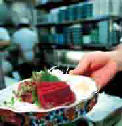|
Tests on whalemeat on sale in Japan have revealed astonishing levels of mercury. While it has long been known that the animals accumulate heavy metals such as mercury in their tissues, the levels discovered have surprised even the experts.
Two of the 26 liver samples examined contained over 1970 micrograms of mercury per gram of liver. That is nearly 5000 times the Japanese government's limit for mercury contamination, 0.4 micrograms per gram.
At these concentrations, a 60-kilogram adult eating just 0.15 grams of liver would exceed the weekly mercury intake considered safe by the World Health Organization, say Tetsuya Endo, Koichi Haraguchi and Masakatsu Sakata at the University of Hokkaido, who carried out the research. "Acute intoxication could result from a single ingestion," they warn in a draft paper accepted for publication in
The Science of the Total Environment.
The researchers call on the government to impose tighter regulations
on the consumption of whale organs. In particular, they warn that
pregnant women risk poisoning their unborn children. In the 1950s
and early 1960s, hundreds of children around Japan's Minamata Bay
were born with horrific birth defects after their mothers ate seafood
contaminated with mercury compounds, which had been poured raw
into the bay since the 1930s. Thousands more suffered brain damage.
Single mouthful
Even veteran researchers from the Minamata saga were shocked by the new figures. "Hirokatsu Akagi, a director of the National Institute for Minamata Disease, was very surprised," says Endo. "He'd never seen levels above 20 micrograms per gram."
On average, concentrations of mercury in whale and dolphin livers were 370 micrograms per gram, 900 times the government limit. Average levels in kidneys and lungs were also high, about 100 times the limit. None of the samples was below the limit.
In work not yet published, Endo's team has shown that rats suffered acute kidney poisoning after a single mouthful of the most highly contaminated liver. While levels were lower in muscle, Endo told New Scientist that on average it still contained 2.5 to 25 times the limit.
The samples came from small-toothed whales and dolphins, catches of which are not restricted by the International Whaling Commission, the international body that regulates whaling. Mercury becomes concentrated in their internal organs when they eat contaminated fish and squid.
|
